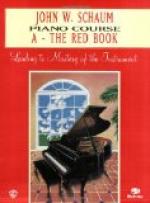“My chief endeavor is to create a desire for good musicianship. To this end I insist upon the study of theory, harmony, ear-training and analysis. In the piano lessons I do not have sufficient time to teach these things. I have assistant teachers who help me with these subjects and also with the technical training. Once a month during the season, my assistant teachers bring their pupils to play for me, and we have a class in piano teaching. There are sometimes eighteen or twenty students who come to a class. I can in this way supervise all the work done, and keep in touch with my teachers, their work, and with all the students.
“On the first Saturday of the month I have my own pupils here for a class; they play for me and for each other. Everything is played from memory, not a printed note is used. Students tell me it is very difficult to play here, where all listen so intently. Especially is it difficult the first time a student plays in class, to keep the mind wholly on what he is doing, with sufficient concentration. Later on, at the end of the season, it comes easier.
“This idea of separating the technical work at the outset from the study of music itself, secures, in my opinion, the most perfect foundation, and later on the best results. It is sometimes wonderful how, with proper training, the hand will improve and develop in a comparatively short time. I often marvel at it myself.”
The writer had the privilege of being one of the guests at the last audition of the season. Eight or nine young artists played a long and difficult program. Among the numbers were a Beethoven sonata, entire; Chopin’s Ballade in A flat major; Cesar Franck, Prelude, Fugue and Variations; a Mozart Fantaisie; Grieg Concerto, first movement; Weber’s Concertstueck, and Chopin’s Scherzo in E. The recital was most instructive from an educational point of view. All the players had repose and concentration, and there were no noticeable slips, though every piece was played from memory. Hands were well arched at the knuckles, fingers curved—with adequate action at the knuckle joint; wrists in normal position, and extremely loose; the whole arm swung from the shoulder and poised over the keys, thus adjusting itself to every requirement of the composition. Every note had its amount of hand or arm weight. The tone quality was full and singing. These points were exemplified even in the playing of the youngest pupils. Furthermore they had an intelligent grasp of the meaning of the music they played, and brought it out with conviction, power, and brilliancy.
IX
CARL M. ROEDER
PROBLEMS OF PIANO TEACHERS
“The progressive teacher’s method must be one of accretion,” said Carl Roeder, when interviewed between lesson hours in his delightful studio in Carnegie Hall. “He gains ideas from many methods and sources, and these he assimilates and makes practical for his work. At the same time he must originate and work out things for himself. This has been my experience.




